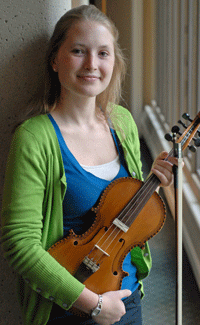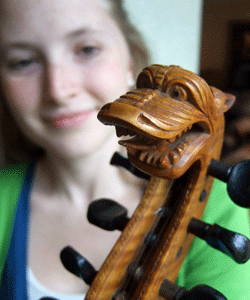You reached this page through the archive. Click here to return to the archive.
Note: This article is over a year old and information contained in it may no longer be accurate. Please use the contact information in the lower-left corner to verify any information in this article.
Fiddling with family history
May 13, 2010
|
|
| “It has a nice sound,” says Meg Granum '11 of the Hardanger fiddle that's on loan from relatives in Norway. “Generally, the older the fiddle is, the better it sounds.” |
Before coming to St. Olaf, Margaret Granum ’11 first heard the Hardanger fiddle played at a Norwegian folk festival. She was immediately captivated by the rich sound produced by nine vibrating strings.
“I fell in love with the instrument,” she says of that initial impression during a vacation to Norway in 2004. “It has such a warm sound.”
Now, after another trip to Norway that brought a special heirloom fiddle into her hands, Granum has a new appreciation for the folk instrument as well as her Norwegian heritage.
In the spring of her sophomore year at St. Olaf, Granum started taking lessons with Andrea Een, associate professor of music and recipient of the prestigious St. Olav's Medal. When she returned to Norway last summer to take classes at the University of Oslo, Granum decided to visit her relatives living in central Norway and share her music with them.
What she wasn’t planning on, though, was the remarkable gift waiting for her. When Granum arrived at her relative Trygve Granheim's home in Fagernes, he presented her with a newly restored Hardanger fiddle. Granum, who was understandably moved by the generous gift, gets to keep the instrument on loan for several years.
“I’ve never heard of anyone loaning an instrument like that to an American,” says Een. “It just shows how much they like and trust Meg.”
|
|
| Granum’s fiddle displays a unique scroll carved in the shape of a dragon head that shows teeth and a notched tongue. The inked edge pattern of the instrument — drawn by hand instead of stenciled — shows that the fiddle was not made in a shop. |
Granum discovered that the fiddle was hand-crafted in 1928 by her grandfather’s cousin, a farmer who made woodcarvings as a hobby. He probably learned to make it by observation and used regular farm tools to carve the wood and tuning pegs.
Een says that homemade fiddles were common in Norway at that time because most farmers were also good woodworkers. “Most of the people that made fiddles in the early days were not what you would call professional luthiers [a maker of stringed instruments],” she explains. “They were making them for their own purposes.”
Trygve’s gesture also is a contribution to St. Olaf; the college owns a limited number of fiddles, so Granum’s possession of the instrument means one more opening for another student to learn the Hardanger fiddle.


